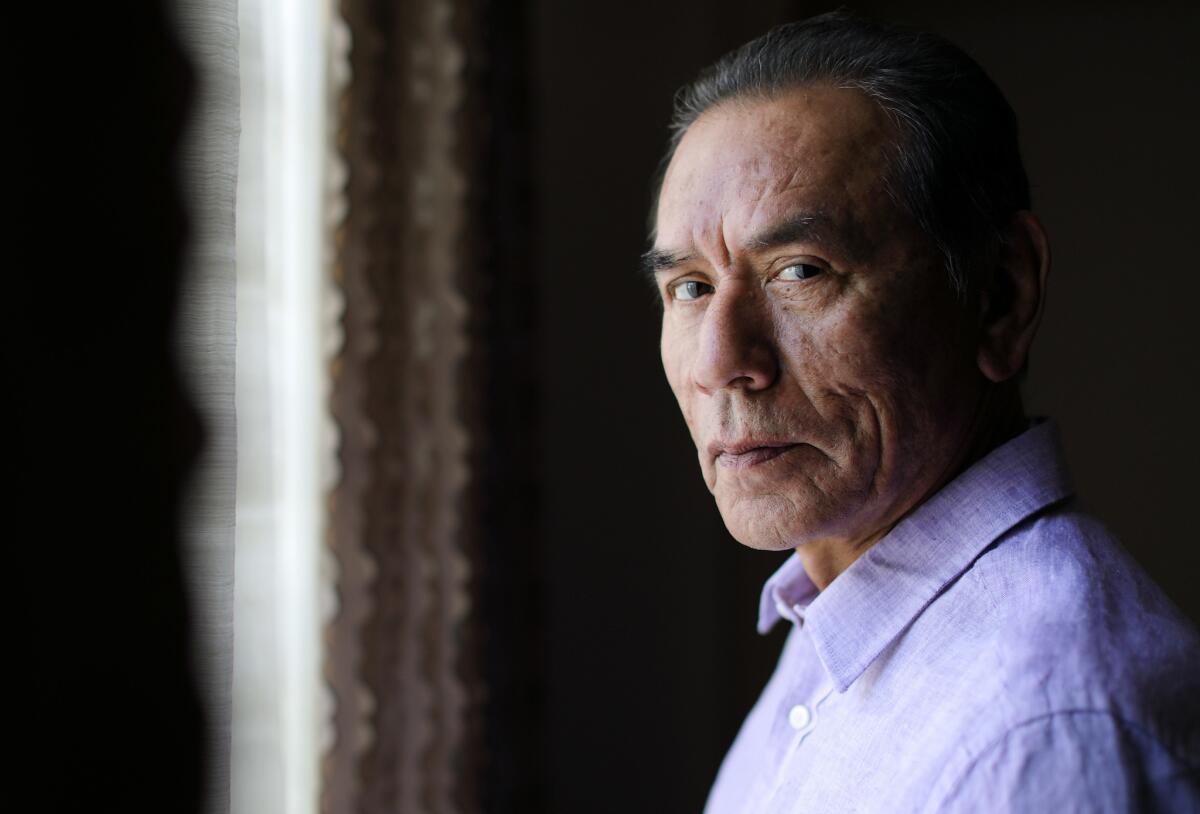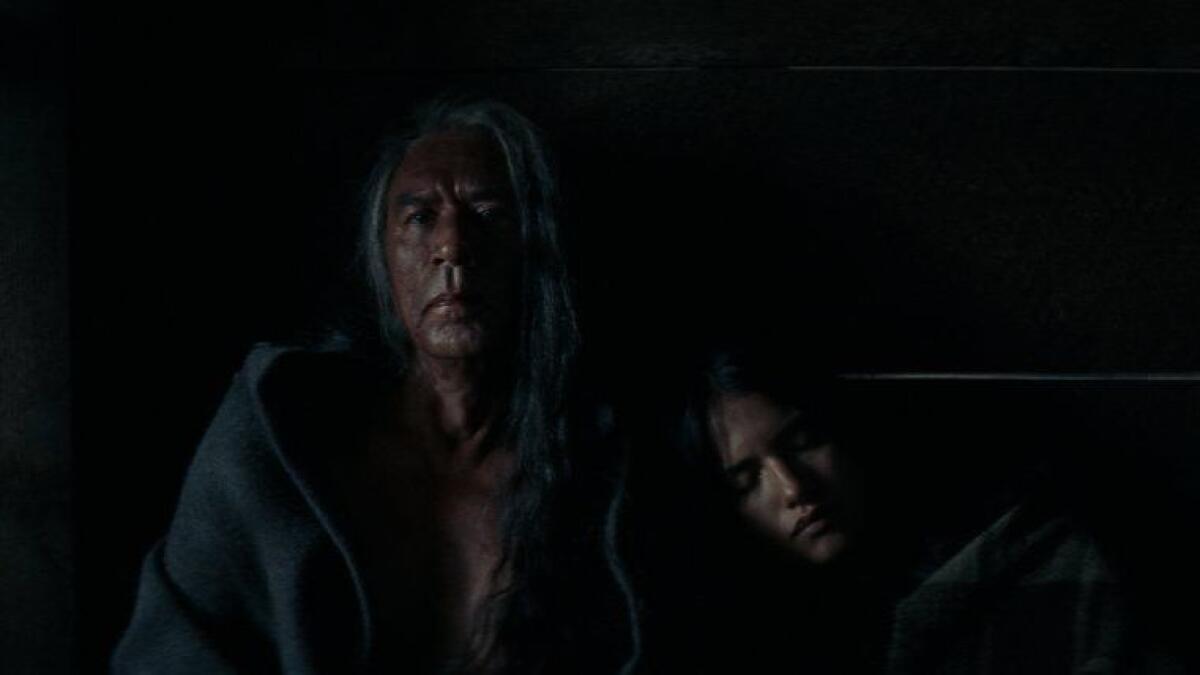Q&A: Wes Studi has been shattering Native American stereotypes for years. It’s time for Hollywood to catch up.

Growing up in rural Oklahoma, speaking only the Cherokee language until age 5, Wes Studi didn’t exactly see Hollywood as the most obvious career path. By the time he started working in movies, he was already in his 40s – but it didn’t take him long to make an impact.
Since breaking out in 1990’s “Dances With Wolves” and as the fierce Huron warrior Magua in 1992’s “Last of the Mohicans,” Studi has earned acclaim for his work in movies like “Geronimo: An American Legend,” “Heat,” “The New World” and “Avatar,” as well as TV projects like “Bury My Heart at Wounded Knee” and “Penny Dreadful.”
In director Scott Cooper’s brutal western “Hostiles,” in theaters Friday, Studi plays Yellow Hawk, an ailing Cheyenne war chief who is reluctantly escorted to his tribal homeland to die by a bigoted Army captain (Christian Bale). Studi, who lives in Santa Fe, spoke with The Times about the film, Native Americans in Hollywood, the persistence of prejudice and his dream of being a grumpy old man.
You’ve been in more than a few westerns over the years. What appealed to you about this script when you read it?
I think the story has something to say beyond the violence, beyond the love story, beyond the normal western story. There was also something I hadn’t done before, which was playing a person who is slowly dying and knows that he is slowly dying. What is it like to be slowly dying, to know that you only have a certain amount of days before you? I really don’t know. But at my age it’s getting nearer — the real thing of dying — and I always wonder about people who get to the point where they can truthfully say, “I do not fear death.”
Your character speaks Cheyenne throughout the film. How big a challenge was that?
I had used Cheyenne to a certain extent a number of years ago when I played Black Kettle [in the 2005 TNT miniseries “Into the West”] but not to this extent. It’s a difficult language. I like to think I have a little edge on it because I’m willing to experiment with different sounds and my tongue is capable of speaking Cherokee, which has a lot of sounds that are made differently. But as far as understanding goes, that part is difficult. It’s phonetics. You’re just making the sounds.
When you were growing up, it was the heyday of the western, but Native American roles were frequently played by white actors and the characters were often stereotypes. Did you see a place for yourself in that genre as a kid?
There was one real Indian that we all recognized when I was a kid, and that was Jay Silverheels. We saw him on a weekly basis [as Tonto] on “The Lone Ranger.”
One time I asked my dad, “How does somebody get into the acting business?” He was fairly dismissive. He told me, “You have to be 6 feet tall and blond-haired and blue-eyed to be in movies and on television.” And at that point it was fairly true — except for Jay Silverheels. And that was a source of pride for everyone.
In the ’70s, with movies like “Little Big Man,” westerns began to have a little different flavor, and I think casting people and filmmakers began to realize, “Hey, maybe we can get a little more authentic in terms of who we cast here.” That kind of opened up the gates. Chief Dan George, Will Sampson and Jay Silverheels all kind of got the ball rolling.
Then it became cyclical. In the ’80s, we all kind of disappeared — I guess we went off to disco or something. [laughs] We didn’t show up again until into the ’90s with “Dances With Wolves.” Now I think more and more people are becoming involved and beginning to make films with their own ideas. We’re just looking for the first big crossover film that is Native American-themed and written and produced and everything.
I think almost every western has to take into consideration what the world is like at the present time.
— Wes Studi

“Hostiles” deals with themes of intolerance and misunderstanding that feel very relevant to the polarized climate we’re in now. Did you have a sense of how that might resonate when you were shooting the film?
When we were shooting, we were all fairly complacent about politics. Last November, we were very close to finishing the movie when we began to hear how the [presidential] polls were slanted one way or another. Then kaboom — everything changed.
I think almost every western has to take into consideration what the world is like at the present time. What “Hostiles” deals with is that there comes a time when enemies have to take into consideration coming together, especially when there’s another common enemy. There is always some point in time when your particular trajectory in life may have to make a turn and adjust.
I think the movie is extremely reflective of how polarized things were in 1890 between these people and is also a good comparison with where we are now. Art imitates life.
While we’re on politics, as a Native American, what went through your head when you saw President Trump make one of his “Pocahontas” cracks at that ceremony last month honoring surviving Navajo code talkers?
I see a person who doesn’t realize that Pocahontas was an actual historical figure. And when I see something like that, it’s actually reminiscent of some people that I grew up around.
I came from a family that was pretty insularly Cherokee. We kept to ourselves — the white people were there and we were here and it was practically a segregated kind of thing. The patronization that they practiced on us — saying, like, “These are our Indians” — that’s exactly what [Trump] was doing. It’s the same old patronizing, pompous way of dealing with us like we’re less than him. To me, it was just infuriating.
I thought it was just indicative of an attitude that had been worked on and was slowly disappearing — and I think it still is. But it’s still hidden away in places and has been encouraged to come out and display itself more. That’s an out-and-out shame. But we’ll figure out a way forward again.
Review: The western springs back to life with 'Hostiles,' a brutal tale of moral survival »
Do you have any roles or types of movies that you’ve never done before on your personal bucket list?
The western has always been for me the bread and butter. It’s the easiest place for an identifiable Native American to be able to work. But I do yearn to be known as an actor rather than a “Native American actor.” I’ve had some non-ethnic-specific roles that have allowed me to do that and I continue to look for those kinds of roles, as well as filmmakers who are willing to take a chance.
I want to do an old curmudgeon movie, like Morgan Freeman and the boys do. [laughs] An old-codger comedy — that’s what I want to do.
ALSO
'Mudbound' tops Mark Olsen's 10 best films of 2017
'Call Me by Your Name,' 'The Florida Project' lead Justin Chang's 12 best films of 2017
Kenneth Turan's best films of 2017 include 'The Shape of Water' and 'The Post'
Only good movies
Get the Indie Focus newsletter, Mark Olsen's weekly guide to the world of cinema.
You may occasionally receive promotional content from the Los Angeles Times.








